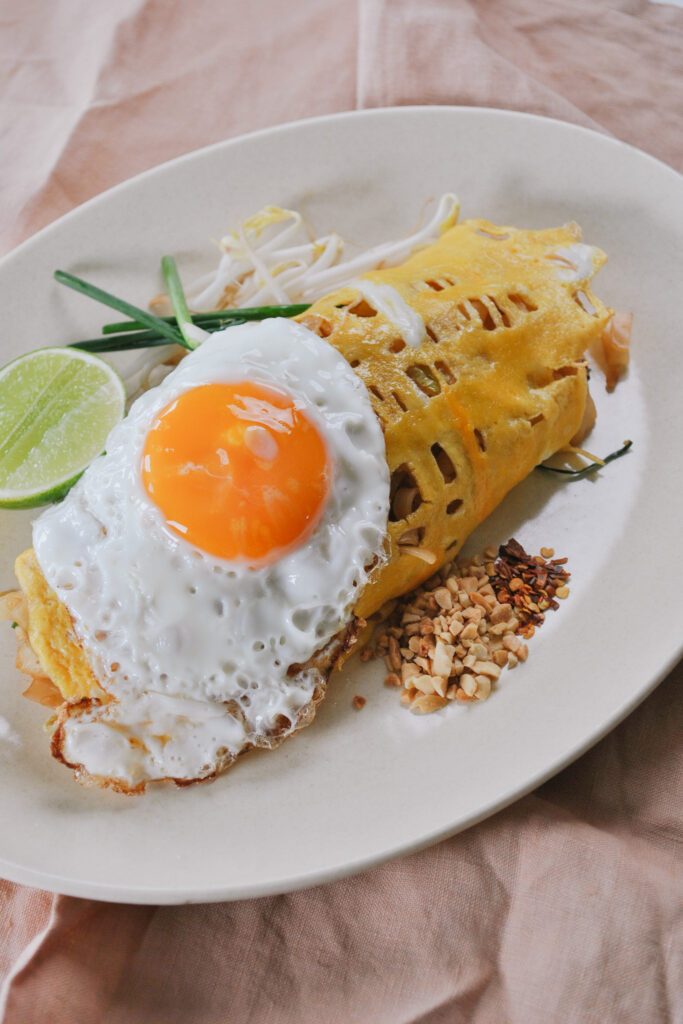The secret to the best pad Thai is pre-soaked rice noodles. That’s it. I’m giving it away in the first line.
Also, if you only have a small wok, I recommend cooking the pad Thai in two separate batches otherwise you risk overcrowding the pan and stewing ingredients.
This rice noodle dish has a great balance of sweet, salty, sour and spicy. It’s usually a dish reserved for a restaurant visit or trip to the its motherland (Thailand) but it’s actually really simple to make at home.
What’s the deal with pad Thai?
Pad Thai means ‘fried Thai’, and despite the dishes wild popularity, it doesn’t have any extreme historical roots. Pad Thai emerged in the 1930s, and there are some claims the dish was actually invented by Chinese migrants rather than Thai locals.
The noodle dish’s popularity is somewhat due to its role in the Thai government’s global restaurant strategy. In the early 2000’s Thai expats abroad were given the option of a “Thai restaurant starter pack” via their home governemnt. The plans helped migrants avoid the headache of business plans and strategy, and in turn gave Thailand an international reputation for delicious food. Initially the government strategy was to create a global Thai restaurant chain, but ended with a boom in Thai eateries with similar traits.
Of course, pad Thai was on the supplied menu.
Nowadays we have more options when it comes to regional Thai foods as Thai expats deivate from the 00s plan. But that plan really made a mark on Australian’s at least – green curry anyone?
Tips before you begin
- Make sure to soak your rice noodles for an hour before cooking, it helps to create a chewy texture and avoids them breaking apart so easily.
- Use a large wok or frying pan and try not to overcrowd it. Cook in two batches if you need.
- You can make the egg nets ahead of time, then just cook the noodles and wrap to serve when it’s dinner time.
- Ain’t nothin wrong with frozen prawns.
- Last one, you can find tamarind paste in jars at most asian grocers or some supermarkets. If you buy pulp, make sure to remove the seeds first.
Double egg pad Thai
Ingredients
Pad Thai sauce
For the noodles
To serve
Instructions
-
In a small bowl, crack four eggs, season with a pinch of salt and beat lightly. Place the mix into a clean squeezy bottle and set aside.
-
Place a medium non-stick pan over medium heat and pre-heat. Add a little neutral oil, then take your squeeze bottle of egg mix and draw a net pattern with the egg by zigzagging lengthways covering the base of the pan, then turning 90 degrees and repeating the zigzag to create a hash pattern. Allow the egg net to set fully before removing from the pan. Set aside on a clean dinner plate then repeat with the remaining egg to make four nets.
-
Wipe or rinse out the same pan, then place back on the heat and add the palm sugar. Melt the sugar and allow it to caramelise. Meanwhile, mix together the fish sauce, tamarind and water. Once the sugar begins to brown, add the fish sauce mix. Be careful as it may splatter a little as the sugar is very hot. Turn the heat down and mix well until the caramel is dissolved. Set aside to cool.
-
For the pad Thai, place a large wok over high heat to pre-heat. Add oil and prawns, toss to cook briefly then add tofu and garlic and stir-fry for a few minutes until tofu becomes golden at the edges. Add the noodles, sauce and toss to coat everything well, continue to cook until noodles become slightly translucent. Add the peanuts, chilli, garlic chives and beansprouts and toss until sprouts are wilted slightly.
-
To serve, place a portion of pad Thai noodles into the centre of the egg net (around 1 cup), roll over and tuck the edges of the egg net under the noodles to make a neat package. This is easiest done with clean hands.
-
Once you’ve assembled each egg net pad Thai, place a large frypan over medium heat, add neutral oil and fry four eggs until crispy on the bottom and whites are cooked through.
-
Place a fried egg ontop of each pad Thai bundle, then garnish with a little extra beansprouts, chives, peanuts, chilli and a lime wedge.



